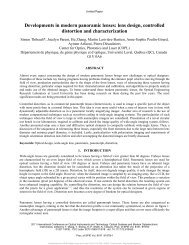Multi-task single lens for automotive vision applications - LRIO
Multi-task single lens for automotive vision applications - LRIO
Multi-task single lens for automotive vision applications - LRIO
Create successful ePaper yourself
Turn your PDF publications into a flip-book with our unique Google optimized e-Paper software.
Figure 5: Fujitsu’s multi-camera viewing system<br />
In the next section, the authors will explain how the panomorph <strong>lens</strong> may provide the ideal solution to the modern<br />
driver’s viewing requirements. We will also explain how to use the panomorph <strong>lens</strong>’ key features to avoid blind zones,<br />
and we will demonstrate how just one panomorph sensor can provide a variety of different views.<br />
3 THE CONCEPT OF PANOMORPH TECHNOLOGY<br />
Many <strong>lens</strong>es with a camera sensor (CMOS or CCD) are naturally suited to provide surround-monitoring of vehicles.<br />
However, due to the camera’s large field-of-view (FoV), any virtual view generated electronically and pointed in a<br />
specific direction suffers from low resolution 1 . Consequently, to get a high-resolution surround image, a high-resolution<br />
sensor is required, which leads back to the issue of cost.<br />
Panomorph <strong>lens</strong>es, on the other hand, can control distortion. This alone is considered a major enhancement in panoramic<br />
<strong>vision</strong> 6 . By using a distortion-control approach and anamorphic image mapping, both patented by ImmerVision,<br />
panomorph <strong>lens</strong>es provide a unique full hemispheric field coverage. In contrast to other types of panoramic imagers that<br />
suffer from blind zones (catadioptric cameras), low-image numerical aperture and high distortion -- the panomorph <strong>lens</strong><br />
uses distortion as a design parameter, to provide a higher-resolution coverage where needed.<br />
Panomorph <strong>lens</strong>es also feature an anamorphic image mapping of the full hemispheric field, resulting in an ellipse-image<br />
footprint rather than the circle or annular footprint that other types of panoramic imagers produce. This feature provides<br />
an immediate 30% gain in pixels on the sensor (the ellipse footprint matches the ratio of a CCD or CMOS imager). This<br />
combination of distortion control and anamorphic design provides an important gain in resolution pixel/degree in the<br />
zones of interest, and an advantage over all other types of panoramic imagers. Finally, the main benefit of panomorph<br />
optics is its custom-design approach, meaning that the panoramic <strong>lens</strong> and the image projection software can be<br />
customized to meet real and very specific needs in visible or infra-red <strong>applications</strong> 7 .<br />
Figure 6a and 6b: Images taken with a fisheye <strong>lens</strong> (6a, left) and with a panomorph <strong>lens</strong> (6b, right).<br />
Green boxes represent equivalent areas.<br />
Proc. of SPIE Vol. 7314 731409-6<br />
Downloaded from SPIE Digital Library on 10 Jun 2011 to 132.203.118.98. Terms of Use: http://spiedl.org/terms



